Go to Page
[Hand of J. O'Donovan:]
October 23rd 1838
Dear Sir,
I want the boundaries of the Dioceses in Connaught as established at the Synod of Rath Breasail, and the account of the deaneries in the dioceses of Tuam Kilmacduagh and Clonfert as given in some of the visitation books.
We intend to finish the baronies of Leitrim (and Longford) first, and then proceed to Gort where we can do the barony of Kiltartan, after which we intend to go on the Mail Coach to Limerick and thence to Mountrath in the Queen's County Do you think this the cheapest and most expeditious mode of moving to the Queen's County? It were better if we could do Wicklow first before the severe weather commences.
OF THE PARISH OF KILCLOONEY
This parish which contains the celebrated town of Ballinasloe, is bounded on the north by the parish of Kill-Gerrill, on the West by Aughrim, on the South by Cloontooskert-O'Many, and on the East by the River Suck, and the County of Roscommon. It was dedicated to the great St. Grellan, whose well gives name to one of its townlands, and whose Crozier was preserved at Ahascragh till a few years ago by the family of Cronnelly. The Life of this Saint was extant in the time of Duald Mac Firbis of Lecan, who quotes it as an authority to prove that the Firvolgs were powerful in Hy-Many in the 6th century. Hujus Sancti baculus nunc non est inventus.
St. Grellan is mentioned in the tract on Hy-
Many preserved in the book of Lecan fol. 92, as one of the distinguished Saints of that regiunculum to whose Coarbs the men and women paid a yearly tribute. This saint presided over the battles of Hy-Many {a very curious occupation for the spirit of a saint residing in the heavenly mansion, unless indeed that heavenly spirits are employed to cut off the superabundant population of territories by wars as well as by plagues} and for this reason, his crozier or some other of his relics, was always carried about in O'Kelly's (0'Many's) standard, in the same manner as the Cathach {praeliator} of St. Columbkille was carried by O'Donnell to ensure success in battle. Sacred standards of this description were not peculiar to the ancient Irish, for the Popes often blessed standards for the Continental Kings and Emperors, but this is so well known already
that it is unnecessary here to give any instances.
We read in the tract on Hy-Many above referred to that the Sts. Patrick, Caireall, and Greallan were the three patron Saints of Hy-Many, Caireall having the superintendance of the district extending from the stream of Glaisi Uair to Glun Padruig and Greallán and Patrick presiding over the tract extending thence to the river Shannon. This gives us an idea of how parishes were originally formed.
See this tract literally translated and minutely annotated in my account of the territory of Hy-Many and its tribes and sub-divisions.
The well of Tobar Ghrealláin lying in a townland which bears its name, was formerly looked upon as a most miraculous spring, and even now when the Clergy are determined to de-secrate all the springs
which had been con-secrated by the clergy of the primitive ages, the people perform stations at it unknown to their pastors, being convinced that the blessing of St. Greallain cannot be rendered null and void by a man who (only) studied a few years at Maynooth, and who never was able to perform one miracle. A "pattern" was formerly, and I believe, is still, held at this well on the 29th of September which is believed to be St. Greallan's day. Greallán Easpog - 17th Septr. {Calendar} Greallán Lainne - 16 Septr.]
The old parish church of Cill Chluana stands on the "Esker" about one mile to the North of Ballinasloe. It is in very good preservation, but most certainly not the original church erected by St. Gre(a)llan, as its style will, at once, shew to any one of antiquarian skill or common observation. It is 51 feet in length and 17 in breadth. The south side wall contains a beautiful doorway in the pointed Gothic style, which is very
low in consequence of the earth being raised by interments, but if the earth were removed it would be found to be more than six feet high. The same wall contains a well built window {not in the lancet style} arched semicircularly at the top and measuring 5 (ft 3 inches) feet [sic] in height, and lft. 6inches. in breadth. The East gable contains a window of the same dimensions, style and characteristics. The west gable contains a very small window measuring 1ft. 6in by 0ft. 5in. The north side wall is featureless, as usual in churches of this age. The side walls are about 8ft. 6inches. in height, but they were originally (higher) as the earth has been a good deal raised by interments both inside and outside the church.
Many persons, and I believe antiquarians among the rest, look upon this as a most ancient church, that is, one erected in the primitive age of the Irish church, but when one compares it with those churches which are historically known to belong to
the primitive ages, he will find that it exhibits none of their characteristic features.
I shall here lay down rules which I have formed by induction from the comparison of many old churches in Ireland, by which (rule [s]) I am persuaded the ancient churches can be distinguished from the modern ones.
1. CHARACTERISTICS OF THE PRIMITIVE IRISH CHURCHES
1. They are always of small dimensions seldom exceeding 15 feet in breadth or 36 in length.
2. They are invariably built of large stones and contain (but a small quantity of) lime and sand cement, which is exceedingly good because the lime was burned by charcoal. (The lime burned by charcoal is much better for making mortar than that burned by turf or collum - why?)
3. They contain but one doorway (each) which is invariably placed in the middle of the west gable, measuring from 5 [feet] six [inches] to 6 [feet] 6 [inches] in height and being always narrower at the top than at the bottom, sometimes by 4 and sometimes
by 5 inches. The following is a representation of the door way of a primitive Irish church as the antiquarian will learn from those in the churches (of) St. Fechin (Fore), St. Fursa (Killursa), Bishop Mel (Ardagh), St. Tiernan (Kiltiernan), St. Brendan (Inis Gluaire), St. Derivla (Kilmore- Erris), &c,
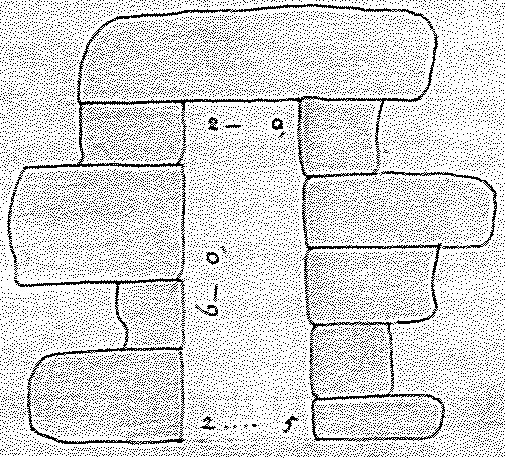
4. The south side wall never contains a doorway, but generally one window (sometimes) in the round lancet style, and sometimes in the rectilineally pointed style. Here a distinction must be drawn (between) the ancient pointed style and the Gothic pointed style: Every doorway and window in the ancient style are at top rectangular, perfectly (semi)circular, or
rectilineally pointed; {doorways however are never pointed at all, but windows are} while in the Gothic style they are curvilineally pointed. The two following are the only forms of ancient windows to be found in Ireland -
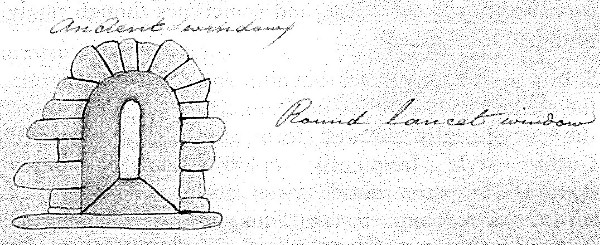
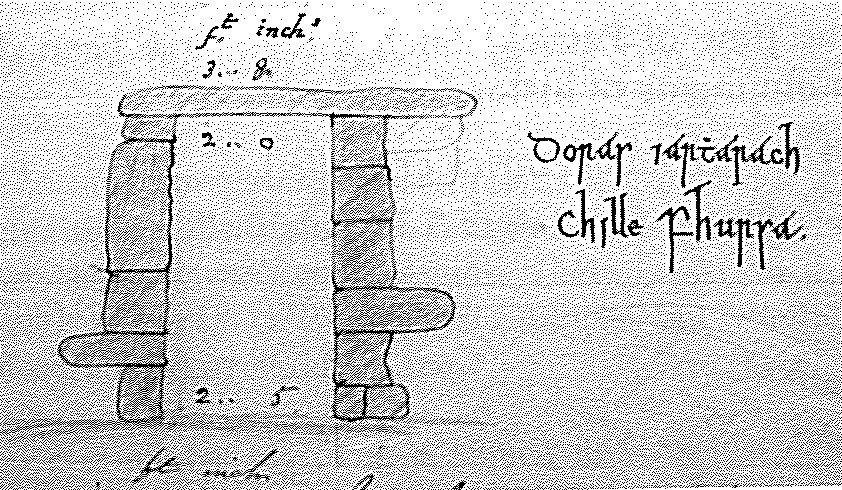
5. It must be received as an unquestionable fact that the curvilineal form (of doorways or windows) is not to be found in any church older than the year 1126.
The East gable contains a window in the round lancet form {never in the rectilineally pointed] under which the altar was placed.
In the 8th and 9th and perhaps up to the beginning of the 12th century many beautiful and tastefully ornamented doorways were erected on distinguished churches in Ireland, and often inserted instead of the more primitive ones, but it requires great skill and judgement to refer many of them to their exact dates, such as the exquisitely beautiful doorway on the church of Rathain near Tullamore which is not in character with the remaining features of that little chapel.
It will be found also that many windows in the Curvilineally pointed style have been inserted in many churches, such as the one (nearly) of flower (fleur) de Leuce form, now to be seen in the east gable of the church of St. Fechin at Fore. Some have supposed such windows to be
coeval with the primitive churches in which they are found, but this is a most egregious error, for it is an undeniable fact that no window of a curvilineally pointed form is to be found in any church erected previously to the year 1126.
CHARACTERISTICS OF THE PARISH CHURCHES ERECTED IN IRELAND FROM THE YEAR 1180 DOWN TO THE PERIOD OF THE REFORMATION
1. They are found to vary in dimensions according to the importance of the parish but the average size is 60 feet in length and 20 in breadth not including the thickness of the walls.
2. They are not built of large stones, but often of remarkably small ones. A good deal of lime and sand mortar is used,
which is a strong characteristic to distinguish them from the primitive churches. The cement though plentifully used is however good, and the lime was evidently burned with wood.
3. They very rarely contain but (more than) one doorway, and this is never placed in the west gable, as in the primitive churches, but invariably in the south side wall within a few feet of the south-west corner. This doorway is generally 6ft. 4inches. in height, and always curvilineally pointed at the top, and the stones are usually chiselled and very often ornamented. The style and position of the door-ways are two very sure guides to the antiquarian to distinguish the comparatively modern from
the primitive churches
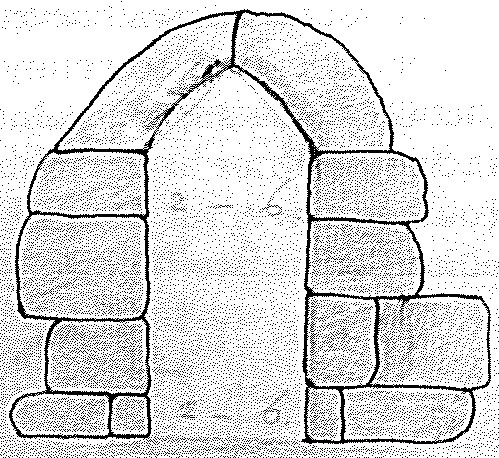
4. The south side wall contains besides the door, a window in the curvilineally pointed lancet, and sometimes though rarely in the round style
5. It is an undoubted fact that although the ancient style exhibits no feature of the curvilineally pointed form, the Gothic style frequently exhibits features in the round style and sometimes in the mixed style. Thus you will find in many churches of the Gothic ages a (lancet) window in the
east gable, formed perfectly semicircular at top on the inside, and curvilineally pointed where it narrows outside, thus,
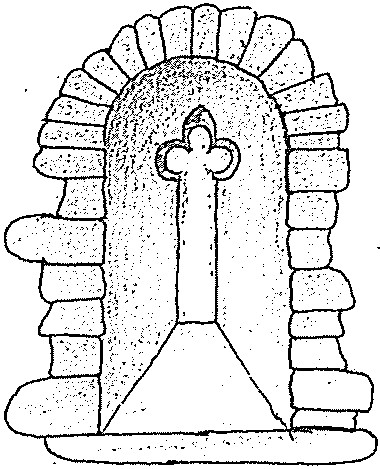
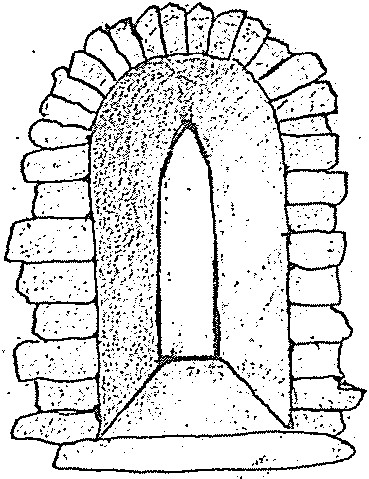
6. The west gable contains no doorway as in the ancient churches, but instead thereof a small window frequently in a quadrangular form, about 2 feet in height and 6 inches in breadth,
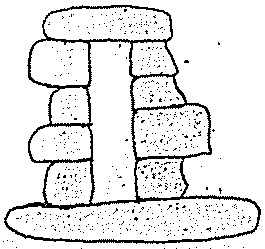
7. In some of the more important churches the east gable contains a window of this form, which is also found in all the abbies.
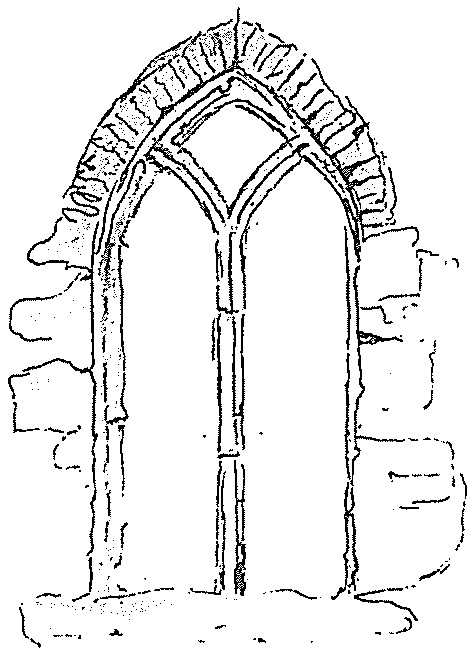
Others contain (lancet headed) windows of this form pointed inside and outside,

The foregoing detail of the characteristic features of the primitive and Gothic parish churches drawn from an actual comparison of the greater part of the old churches of the North and West of Ireland will assist the young antiquarian student in distinguishing between two classes of churches in Ireland, the former being very rare and the latter of frequent occurrence. It will at once appear from it that the old church of Kilclooney which is generally supposed to be very ancient, cannot be older than the 12th century, for the position and form of the doorway, and the general appearance of the architecture identify it with the Gothic or curvilineally pointed style which was not introduced into this country
until the latter end of the 12th century.
In this parish is situated the famous town of Ballinasloe, celebrated all over Europe for its (extensive) fairs. Its october fair is a more celebrated one than the fair of Tailteann held in August ever was, but it must be acknowledged that the fair of Tailteann was a far more noble and romantic one in as much as the monarch was generally present, and various military sports were carried on in one place, while they bought and sold at Tulach na coibhche. Ballinasloe October fair is however more useful, and perhaps more civilized in consequence of the great quantity of civilized articles brought to it from Dublin and England, such as clothes of every fashion and description, boots, shoes, cutlery, pistols,
guns, &c and one is astonished to find there people who call themselves French barbers with "great arrivals" of false tresses, whiskers &c, and a street full of strolling players. The fair green is a spacious and most excellent one, and the number and quality of cattle exposed for sale great and appears wonderful to a stranger who considers that Ballinasloe is in Connaught. French and English people come thither to sell horses and different breeds of cattle.
The name of this town is in Irish Béal Átha na Sluaigheadh, the mouth of the ford of the hosts, which seems to indicate that the locality was a place of public meetings when the name was first imposed but we have no historical monument (as far as we have yet discovered) of the period at which or the reason for which this name was originally given, nor have we, as far as I know, any record of
the period at which (cattle) fairs were established here.
The ancient name of the place was Dunlo {Dun-Leodha} which is still the name of a street in the town, and of a townland lying to the west of the Suck which contains the greater part of the town. This name it received from a fort which stood over the Suck where the present Roman Catholic chapel stands, but which is now just destroyed. The name of Dun Leodha appears in the Annals at the year 1114 but Bel atha na Sluaigheadh does not appear in them before the year 1584, from which it may be inferred (with some certainty) that it is not a name of much antiquity. One thing however is certain that Dun Leodha was the name of the fort, bridge and castle of this place previous to the coming of the English, as will appear from the following notices of it collected by the Four Masters in their Annals.
A.D. 1114, Donnell O'Loughlin (Mac Loughlin) {King of Aileach} led an army to Rath Kenny and Eochy O'Mahon (Mac Mahon)
with the Ulidians went to his house and submitted to him as did Donogh O'Lynchy with the Dalaradians, Hugh O'Rourke with the men of Breifny and Morogh O'Melaghlin with the Meathmen. They proceeded afterwards across Athlone to Dún-Leódha, where Torlogh O'Conor with the Connaughtmen, and Niall Mac Loughlin, his own (son), with the nobles of Kinel Connell, joined him. &c.
A.D. 1120 The Bridge of Dun Leódha on the Suck, was erected by Torlogh O'Conor.
A.D. 1124 Three Castles were built by the Connaughtmen, viz. the castle of Dun Leodha (Dunlo) the Castle of Bun-Gaillimhe (Galway-mouth), and the Castle of Cul Maoile (Colooney).
A.D. 1189, Conor Moinmoy {the son of Roderic} King of all Connaught both English and Irish, was slain by a party of his own people and tribe, viz Manus, the son of Flann O'Finaghty {commonly called the Crosach Donn}
Hugh the son of Brian Breifneach, who was the son of Torlogh O'Conor, Mortagh, son of Cathal, son of Dermot, son of Teige, and Gilla na naomh, the son of Gilla Chomain, who was the son of Muireadhach Ban O'Maoilmíchil {Mulvihill} of the Tuatha's. Woe to the party who set on foot this conspiracy against the life of the heir presumptive to the throne of Ireland. To him the greater part of Leath Mhogha had submitted as their King for Donnell O'Brien "had gone into his house" at Dun Leódha where he had been entertained for a week &c.
A.D. 1584. Sir Nicholas Malby, Governor of the province of Connaught, died. He was skilled in the languages and dialects of Europe. He was brave and victorious in battles fought throughout Ireland, Scotland and France in the service of his sovereign, and amply rewarded had he been for his services, for he received a suitable remuneration from the Queen, viz the Constableship of Athlone, and the Governorship of Connaught for seven years before his death
and a grant in perpetuity of the town of Roscommon and Ballinasloe {Bél atha na Sluaigheadh} for himself and his heirs, the latter he had himself previously wrested from the Earl of Clanrickard.
The truth of this passage is confirmed by an Inquisition taken at Galway in the year 1608, which states that
it was found by an Inquisition taken before John Crofton Esqre. at Athenry 1st of October 1584 that Rickard late Earl of Clanrickard, died 24th July 1582[?], seized in fee and fee taile of the several lands following, viz the manors and castles of Loughreagh, Dunkellin. Leitrim, Clare, Clonecastle, the castle of Clondagawe, the castle of Portumna with 2 quarters, the castle of Ballenasloe with 1½ qr. &c.
And again,
that Ulick B(o)urke {son of this Rickard} did enter into the said Earldome and all and singular the manors, Lordships, Castles &ca {except the Castle of Ballenasloe, and the lands thereunto
belonging now in the possession and tenure of the heirs of Anthony Brabazon}
In the year 1596 An English garrison was placed in Bél átha na sluaigheadh. For the site of the castle of Ballinasloe see my letters from Roscommon County; dated Ballinasloe June ? 1837.
In this parish in the townland of Pollboy situated about a mile from Ballinasloe to the south between the (river) Suck and the canal, is situated a very curious old church or rather monastery in the Gothic style. It is different from any church I have yet seen. It is about 57 feet long and 21 broad. The south side wall which is remarkably high, contains a very beautiful doorway in the Gothic style nearly 10 feet in height, and a lancet (narrow pointed) window 4 feet high and 7 inches broad on the outside. The East gable contains a Gothic window but so covered with ivy that I could not see its form or ascertain its
dimensions. The north side wall is nearly all destroyed. This was probably a monastery not a parish church, but I have no history of it, nor could I get any clue to its history from tradition. It had one loft, and the lower part of the walls is in the Cyclopian style.
There are two Eskers extending westwards from the river Suck, one passing through Ballinasloe, through the parish of Kilclooney and striking the road at Kilmalow, and the other passing through the parish of Cloontooskert, north of the abbey in the direction of Glennaloughaun church; A road called the Esker runs along it for a considerable distance. Which of these the Esker Riada is cannot be ascertained until we know where we lost sight of it in the County of Ros-common. I asked this question twice before
John O'Donovan
